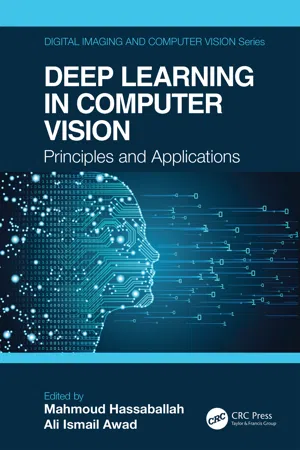
Deep Learning in Computer Vision
Principles and Applications
- 322 pages
- English
- ePUB (mobile friendly)
- Available on iOS & Android
Deep Learning in Computer Vision
Principles and Applications
About this book
Deep learning algorithms have brought a revolution to the computer vision community by introducing non-traditional and efficient solutions to several image-related problems that had long remained unsolved or partially addressed. This book presents a collection of eleven chapters where each individual chapter explains the deep learning principles of a specific topic, introduces reviews of up-to-date techniques, and presents research findings to the computer vision community. The book covers a broad scope of topics in deep learning concepts and applications such as accelerating the convolutional neural network inference on field-programmable gate arrays, fire detection in surveillance applications, face recognition, action and activity recognition, semantic segmentation for autonomous driving, aerial imagery registration, robot vision, tumor detection, and skin lesion segmentation as well as skin melanoma classification. The content of this book has been organized such that each chapter can be read independently from the others. The book is a valuable companion for researchers, for postgraduate and possibly senior undergraduate students who are taking an advanced course in related topics, and for those who are interested in deep learning with applications in computer vision, image processing, and pattern recognition.
Frequently asked questions
- Essential is ideal for learners and professionals who enjoy exploring a wide range of subjects. Access the Essential Library with 800,000+ trusted titles and best-sellers across business, personal growth, and the humanities. Includes unlimited reading time and Standard Read Aloud voice.
- Complete: Perfect for advanced learners and researchers needing full, unrestricted access. Unlock 1.4M+ books across hundreds of subjects, including academic and specialized titles. The Complete Plan also includes advanced features like Premium Read Aloud and Research Assistant.
Please note we cannot support devices running on iOS 13 and Android 7 or earlier. Learn more about using the app.
Information
1 Accelerating the CNN Inference on FPGAs
1.1 Introduction
1.2 Background on CNNs and Their Computational Workload
Table of contents
- Cover
- Half-Title
- Series
- Title
- Copyright
- Contents
- Foreword
- Preface
- Editors Bio
- Contributors
- Chapter 1 Accelerating the CNN Inference on FPGAs
- Chapter 2 Object Detection with Convolutional Neural Networks
- Chapter 3 Efficient Convolutional Neural Networks for Fire Detection in Surveillance Applications
- Chapter 4 A Multi-biometric Face Recognition System Based on Multimodal Deep Learning Representations
- Chapter 5 Deep LSTM-Based Sequence Learning Approaches for Action and Activity Recognition
- Chapter 6 Deep Semantic Segmentation in Autonomous Driving
- Chapter 7 Aerial Imagery Registration Using Deep Learning for UAV Geolocalization
- Chapter 8 Applications of Deep Learning in Robot Vision
- Chapter 9 Deep Convolutional Neural Networks: Foundations and Applications in Medical Imaging
- Chapter 10 Lossless Full-Resolution Deep Learning Convolutional Networks for Skin Lesion Boundary Segmentation
- Chapter 11 Skin Melanoma Classification Using Deep Convolutional Neural Networks
- Index